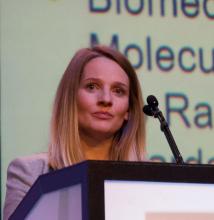User login
SAN ANTONIO – For detection of genomic aberrations in patients with advanced breast cancer, sensitivity of circulating tumor DNA (ctDNA) testing is effectively equivalent to that of tumor tissue sequencing, based on results of the plasmaMATCH trial.
When plasma and tumor tissue samples were collected within 60 days of one another, sensitivity of ctDNA testing was 98% for digital droplet PCR (ddPCR) and 100% for targeted sequencing with Guardant360, reported lead author Belinda Kingston, MB, ChB, of The Institute of Cancer Research, London.
In addition to analyzing ctDNA accuracy, Dr. Kingston and colleagues explored characteristics of genomic alterations in relation to one another and to disease subtypes.
“We have defined the genomic landscape of advanced breast cancer using ctDNA analysis,” Dr. Kingston said during a presentation at the San Antonio Breast Cancer Symposium.
The open-label plasmaMATCH trial, conducted at multiple centers in the United Kingdom, involved more than 1,000 patients with advanced breast cancer. The present analysis included 1,025 patients who underwent ctDNA testing via ddPCR, which screened for alterations in PIK3CA, ESR1, AKT1, and ERBB2. Eight hundred patients also underwent ctDNA testing with Guardant360 targeted sequencing (a 73-gene panel), while 77 patients additionally had tumor tissue sequencing performed on a fresh or frozen sample of metastatic tissue (a 16-gene panel).
Results showed that individual gene level agreement between the two ctDNA techniques ranged from 96% to 99% with kappa scores of at least 0.89. As described above, sensitivity of these tests, compared with tumor tissue sequencing, approached 100%.
Following this overview of diagnostic accuracy, Dr. Kingston described a series of genomic trends, focusing first on targetable alterations.
Both ctDNA techniques revealed that ESR1 mutations were common in cases of hormone receptor (HR)-positive disease, including approximately 40% of patients with HER2-negative breast cancer and approximately 20% of patients with HER2-positive breast cancer. In contrast, ESR1 mutations were found in less than 1% of patients with HR-negative disease. Although ERBB2 amplification was predominantly found in patients with HER2-positive breast cancer, this alteration was found in 1%-2% of patients with HER2-negative disease.
For the remainder of the presentation, Dr. Kingston focused on ctDNA targeted sequencing data.
Within this cohort of 800 participants, 92.9% of patients had a ctDNA alteration. The mean number of pathogenic alterations was 2.7; Dr. Kingston noted that, on average, patients with HR-positive, HER2-negative disease had significantly more alterations than did those with triple-negative breast cancer (3.0 vs 1.8; P less than .0001).
“We found that specific genes are enriched in certain breast cancer subtypes,” Dr. Kingston said, pointing out the “notable” rate of ERBB2 mutations (14%) in HER2-amplified disease.
Among patients with HR-positive disease, those who were HER2-negative often had ESR1 and KRAS mutations, whereas those with HER2-positive disease often had ESR1 mutations but not KRAS mutations.
Heterogeneity analysis showed that alterations in certain genes were clonally dominant, including AKT1, PIK3CA, GATA3, and TP53, while others were more often subclonal, including ESR1, RB1, SMAD4, and KRAS.
A closer look at frequency of alterations showed that AKT1, CDH1, and GATA3 were typically found as the only gene alteration present; in contrast, ESR1 alterations were often accompanied by multiple other gene hits.
Returning to targetable genes, the investigators found that there was significant variation in clonal dominance of pathogenic mutations in ESR1 and PIK3CA. A deeper analysis revealed that PIK3CA mutations were often double mutations in HR-positive disease, and that subclonal second mutations were found at APOBEC mutagenesis sites.
Carlos Arteaga, MD, of the University of Texas Southwestern Medical Center, Dallas, commented on the findings after the presentation and asked Dr. Kingston about a potential blind spot in the data.
“You indicated there was overall concordance between ddPCR and the targeted capture assay,” Dr. Arteaga said. “That suggests that you did select the better hotspots; however, you could be missing some genomic space captured by the targeted capture assay that may change over time as a function of tumor evolution, drug resistance, or whatever,” Dr. Arteaga said. “So have you assessed how stable that component is as a function of time and treatment, or do you plan to do that?”
Dr. Kingston said that although these data are not yet available, plans are underway to perform ctDNA during the treatment process, so that concordance between the two techniques may be evaluated over time.
The investigators disclosed ties with Puma Biotechnology, AstraZeneca, Guardant Health, and Bio-Rad.
SOURCE: Kingston et al. SABCS. 2019 Abstract GS3-07.
SAN ANTONIO – For detection of genomic aberrations in patients with advanced breast cancer, sensitivity of circulating tumor DNA (ctDNA) testing is effectively equivalent to that of tumor tissue sequencing, based on results of the plasmaMATCH trial.
When plasma and tumor tissue samples were collected within 60 days of one another, sensitivity of ctDNA testing was 98% for digital droplet PCR (ddPCR) and 100% for targeted sequencing with Guardant360, reported lead author Belinda Kingston, MB, ChB, of The Institute of Cancer Research, London.
In addition to analyzing ctDNA accuracy, Dr. Kingston and colleagues explored characteristics of genomic alterations in relation to one another and to disease subtypes.
“We have defined the genomic landscape of advanced breast cancer using ctDNA analysis,” Dr. Kingston said during a presentation at the San Antonio Breast Cancer Symposium.
The open-label plasmaMATCH trial, conducted at multiple centers in the United Kingdom, involved more than 1,000 patients with advanced breast cancer. The present analysis included 1,025 patients who underwent ctDNA testing via ddPCR, which screened for alterations in PIK3CA, ESR1, AKT1, and ERBB2. Eight hundred patients also underwent ctDNA testing with Guardant360 targeted sequencing (a 73-gene panel), while 77 patients additionally had tumor tissue sequencing performed on a fresh or frozen sample of metastatic tissue (a 16-gene panel).
Results showed that individual gene level agreement between the two ctDNA techniques ranged from 96% to 99% with kappa scores of at least 0.89. As described above, sensitivity of these tests, compared with tumor tissue sequencing, approached 100%.
Following this overview of diagnostic accuracy, Dr. Kingston described a series of genomic trends, focusing first on targetable alterations.
Both ctDNA techniques revealed that ESR1 mutations were common in cases of hormone receptor (HR)-positive disease, including approximately 40% of patients with HER2-negative breast cancer and approximately 20% of patients with HER2-positive breast cancer. In contrast, ESR1 mutations were found in less than 1% of patients with HR-negative disease. Although ERBB2 amplification was predominantly found in patients with HER2-positive breast cancer, this alteration was found in 1%-2% of patients with HER2-negative disease.
For the remainder of the presentation, Dr. Kingston focused on ctDNA targeted sequencing data.
Within this cohort of 800 participants, 92.9% of patients had a ctDNA alteration. The mean number of pathogenic alterations was 2.7; Dr. Kingston noted that, on average, patients with HR-positive, HER2-negative disease had significantly more alterations than did those with triple-negative breast cancer (3.0 vs 1.8; P less than .0001).
“We found that specific genes are enriched in certain breast cancer subtypes,” Dr. Kingston said, pointing out the “notable” rate of ERBB2 mutations (14%) in HER2-amplified disease.
Among patients with HR-positive disease, those who were HER2-negative often had ESR1 and KRAS mutations, whereas those with HER2-positive disease often had ESR1 mutations but not KRAS mutations.
Heterogeneity analysis showed that alterations in certain genes were clonally dominant, including AKT1, PIK3CA, GATA3, and TP53, while others were more often subclonal, including ESR1, RB1, SMAD4, and KRAS.
A closer look at frequency of alterations showed that AKT1, CDH1, and GATA3 were typically found as the only gene alteration present; in contrast, ESR1 alterations were often accompanied by multiple other gene hits.
Returning to targetable genes, the investigators found that there was significant variation in clonal dominance of pathogenic mutations in ESR1 and PIK3CA. A deeper analysis revealed that PIK3CA mutations were often double mutations in HR-positive disease, and that subclonal second mutations were found at APOBEC mutagenesis sites.
Carlos Arteaga, MD, of the University of Texas Southwestern Medical Center, Dallas, commented on the findings after the presentation and asked Dr. Kingston about a potential blind spot in the data.
“You indicated there was overall concordance between ddPCR and the targeted capture assay,” Dr. Arteaga said. “That suggests that you did select the better hotspots; however, you could be missing some genomic space captured by the targeted capture assay that may change over time as a function of tumor evolution, drug resistance, or whatever,” Dr. Arteaga said. “So have you assessed how stable that component is as a function of time and treatment, or do you plan to do that?”
Dr. Kingston said that although these data are not yet available, plans are underway to perform ctDNA during the treatment process, so that concordance between the two techniques may be evaluated over time.
The investigators disclosed ties with Puma Biotechnology, AstraZeneca, Guardant Health, and Bio-Rad.
SOURCE: Kingston et al. SABCS. 2019 Abstract GS3-07.
SAN ANTONIO – For detection of genomic aberrations in patients with advanced breast cancer, sensitivity of circulating tumor DNA (ctDNA) testing is effectively equivalent to that of tumor tissue sequencing, based on results of the plasmaMATCH trial.
When plasma and tumor tissue samples were collected within 60 days of one another, sensitivity of ctDNA testing was 98% for digital droplet PCR (ddPCR) and 100% for targeted sequencing with Guardant360, reported lead author Belinda Kingston, MB, ChB, of The Institute of Cancer Research, London.
In addition to analyzing ctDNA accuracy, Dr. Kingston and colleagues explored characteristics of genomic alterations in relation to one another and to disease subtypes.
“We have defined the genomic landscape of advanced breast cancer using ctDNA analysis,” Dr. Kingston said during a presentation at the San Antonio Breast Cancer Symposium.
The open-label plasmaMATCH trial, conducted at multiple centers in the United Kingdom, involved more than 1,000 patients with advanced breast cancer. The present analysis included 1,025 patients who underwent ctDNA testing via ddPCR, which screened for alterations in PIK3CA, ESR1, AKT1, and ERBB2. Eight hundred patients also underwent ctDNA testing with Guardant360 targeted sequencing (a 73-gene panel), while 77 patients additionally had tumor tissue sequencing performed on a fresh or frozen sample of metastatic tissue (a 16-gene panel).
Results showed that individual gene level agreement between the two ctDNA techniques ranged from 96% to 99% with kappa scores of at least 0.89. As described above, sensitivity of these tests, compared with tumor tissue sequencing, approached 100%.
Following this overview of diagnostic accuracy, Dr. Kingston described a series of genomic trends, focusing first on targetable alterations.
Both ctDNA techniques revealed that ESR1 mutations were common in cases of hormone receptor (HR)-positive disease, including approximately 40% of patients with HER2-negative breast cancer and approximately 20% of patients with HER2-positive breast cancer. In contrast, ESR1 mutations were found in less than 1% of patients with HR-negative disease. Although ERBB2 amplification was predominantly found in patients with HER2-positive breast cancer, this alteration was found in 1%-2% of patients with HER2-negative disease.
For the remainder of the presentation, Dr. Kingston focused on ctDNA targeted sequencing data.
Within this cohort of 800 participants, 92.9% of patients had a ctDNA alteration. The mean number of pathogenic alterations was 2.7; Dr. Kingston noted that, on average, patients with HR-positive, HER2-negative disease had significantly more alterations than did those with triple-negative breast cancer (3.0 vs 1.8; P less than .0001).
“We found that specific genes are enriched in certain breast cancer subtypes,” Dr. Kingston said, pointing out the “notable” rate of ERBB2 mutations (14%) in HER2-amplified disease.
Among patients with HR-positive disease, those who were HER2-negative often had ESR1 and KRAS mutations, whereas those with HER2-positive disease often had ESR1 mutations but not KRAS mutations.
Heterogeneity analysis showed that alterations in certain genes were clonally dominant, including AKT1, PIK3CA, GATA3, and TP53, while others were more often subclonal, including ESR1, RB1, SMAD4, and KRAS.
A closer look at frequency of alterations showed that AKT1, CDH1, and GATA3 were typically found as the only gene alteration present; in contrast, ESR1 alterations were often accompanied by multiple other gene hits.
Returning to targetable genes, the investigators found that there was significant variation in clonal dominance of pathogenic mutations in ESR1 and PIK3CA. A deeper analysis revealed that PIK3CA mutations were often double mutations in HR-positive disease, and that subclonal second mutations were found at APOBEC mutagenesis sites.
Carlos Arteaga, MD, of the University of Texas Southwestern Medical Center, Dallas, commented on the findings after the presentation and asked Dr. Kingston about a potential blind spot in the data.
“You indicated there was overall concordance between ddPCR and the targeted capture assay,” Dr. Arteaga said. “That suggests that you did select the better hotspots; however, you could be missing some genomic space captured by the targeted capture assay that may change over time as a function of tumor evolution, drug resistance, or whatever,” Dr. Arteaga said. “So have you assessed how stable that component is as a function of time and treatment, or do you plan to do that?”
Dr. Kingston said that although these data are not yet available, plans are underway to perform ctDNA during the treatment process, so that concordance between the two techniques may be evaluated over time.
The investigators disclosed ties with Puma Biotechnology, AstraZeneca, Guardant Health, and Bio-Rad.
SOURCE: Kingston et al. SABCS. 2019 Abstract GS3-07.
REPORTING FROM SABCS 2019


